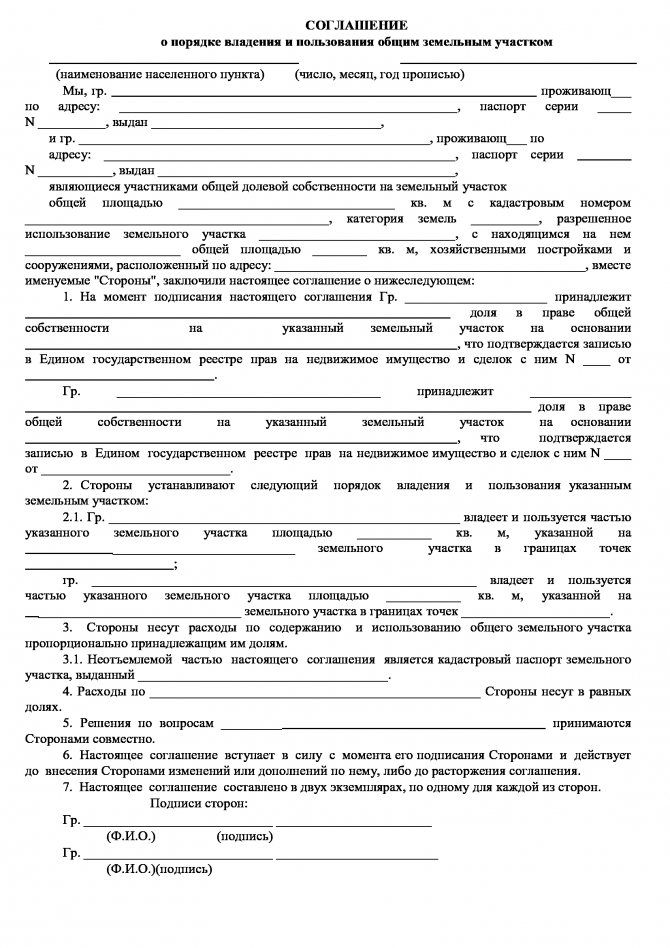Often it is not possible to determine the order of use of a land plot peacefully.
Our lawyer on land issues will tell you how to do everything correctly and without unnecessary mistakes. With the help of a specialist in your field, you will not only decide on the procedure for using the land, but also eliminate the obstacles in using the land that third parties put in your way.
The procedure for determining the procedure for using a land plot
The owner of each apartment in a common building has the right to receive a certain share in the surrounding territory, regardless of the fact that neighbors’ buildings are already located on it.
The main criterion that will guide the official (judge) will be the determination of the share of all participants in the process in the right to use a specific territory. All rights and obligations of the parties are described in the Civil Code of the Russian Federation and the Land Code of the country, which states that the owner of half of the house has the right to half the share of the land around it, and the one who owns 1/5 of the house receives the right to 1/5 of the land around it .
The second criterion in resolving this land issue will be the order that has developed over the years, which was determined from the convenience of each land user, the location of his buildings on the land plot, as well as taking into account plantings of bushes and fruit and berry trees. Thus, the basis for the decision is the tradition of land use that has already been determined over the years, even if it does not correspond to an equal ratio in the common property, all inequalities are compensated by cutting or trimming in another place of the site where the dispute is least clear. The order of land use established over a long period of time is often recognized as logical, including when housing owners change. Repeated appeal to court on the same issue is prohibited by law.
Who can sue to determine the order of use of a land plot?
- Citizens of private houses. Such disputes are different from those that begin when it is impossible to determine the boundaries of plots or to prove ownership. In this case, absolutely all citizens of the country can turn to judges for help.
- Residents of apartment buildings. Determination of the procedure for using a land plot is most often required by owners of houses designed for use by several owners at once because and they have common land, often without any definite division. More questions of order arise when transferring the category of land; not all adjacent land users are satisfied with the decision made to change the purpose of the land plot; litigation begins on this issue.
ATTENTION: A lawyer on land disputes in court with neighbors and third parties gives advice in the video. Subscribe to our YouTube channel and legal advice on land issues in the comments of the video will be free for you.
Legal basis for the use of land plots
Land legal relations in the Russian Federation are regulated by the Land Code and Federal Law No. 221-FZ of July 24, 2007 “On the State Real Estate Cadastre” (hereinafter referred to as Federal Law No. 221-FZ).
Each educational institution has land plots, at least those located under buildings and structures owned by the institutions.
According to paragraph 2 of Art. 7 of the Land Code of the Russian Federation, land plots must be used in accordance with the intended purpose established for them. The legal regime of lands is determined based on their belonging to a particular category and permitted use in accordance with the zoning of the territory.
An institution can use land plots in three cases:
- upon receipt of them for permanent (indefinite) use;
- when purchasing them as property;
- when renting them.
Agreement on determining the procedure for using a land plot
In the event that several owners of the same land plot have disputes regarding the order of use of the land, it is possible to determine the order of use by concluding an appropriate agreement. Such an agreement is a good way of out-of-court settlement of a dispute related to the use of a land plot.
It must be remembered that the procedure for using a land plot in shared ownership can be changed. Moreover, it can be changed again out of court, and again by concluding an agreement or an annex to it. I would like to note that such an agreement is not subject to registration with any government bodies and begins to operate from the moment it is signed (unless it provides for something else).
It is also worth remembering that determining the procedure for using land is not a division of the land plot and, accordingly, does not have the same legal consequences.
It is important to remember that the agreement is drawn up in writing and must contain:
- The date and place of its compilation;
- Data of all legal holders of the land plot;
- General rights and obligations of all site owners;
- Specific rights and obligations of specific site owners;
- The procedure for using communications (if any and are common).
It is worth noting that if the owners of the plot have not come to an agreement on the definition of the use of the land, then a judicial procedure can come to the rescue, the main purpose of which will be to change the order of use of the land plot; this category of disputes is quite common. If it was not possible to reach an agreement, our lawyers will help you draw up a competent statement of claim to determine the procedure for using the land plot, which will increase the chances of a successful resolution of the case in court.
Features of shared use of land
Part of the land may belong to several owners. Each of them has the right to use the site at their own discretion and benefit from it. If the site is owned for a long time, the rules of good neighborliness are established “tacitly”. However, when life circumstances change, it becomes necessary to record the procedure for use on paper. The most common reasons for determining the order of use of land shares:
- The emergence of a new copyright holder . For example, the previous owner sells his share, and the new one does not agree with the previously established division.
- Division of shares between legal successors . Upon entering into an inheritance, ½ of the allotment can be divided between two or another number of persons who cannot agree on the rules for its use.
- Ownership of real estate by strangers . If relatives are inclined to resolve conflicts, then real neighborly wars arise between strangers, which can only be ended in court.
When determining the boundaries of use of a site, a new real estate object does not arise. The essence of the process is to establish boundaries within which shareholders will derive personal benefit from the site without infringing on the rights of others.
First of all, it is necessary to try to resolve the issue without bringing the matter to court, in other words, sit down at the negotiating table and draw up an agreement.
What documents are needed to determine the order of land use?
Shareholders are people who own parts of one plot. In order to specifically determine what part each of them can use, it is necessary to know the boundaries and characteristics of the entire land plot. All data about the site is contained in a document - a cadastral passport.
To determine the procedure for using shares of a land plot, you need to make sure that you have documents confirming the cadastral registration of the property. Without defining external boundaries, division is impossible.
If there is no cadastral passport, you must obtain one after first going through the land surveying process. Read more: How to survey a land plot in shared ownership
A document confirming land ownership is required. It is an extract from the Unified State Register. It is issued on the basis of a document confirming the transfer of ownership from one owner to another. If there is no such document, you must contact Rosreestr, MFC and submit an application to register ownership of the share.
Also, when determining the order of use, the status of the site is important:
- if it belongs to several citizens, then the procedure for use will be determined in proportion to their shares in ownership;
- if the site belongs to several owners of residential premises on the basis of perpetual use rights, its exploitation is determined either in accordance with a previously established procedure or in proportion to their share in the residential premises.
Having a package of documents according to which you can clearly define the characteristics of the disputed object and the right to own it, you can enter into an agreement and go to court.
Claim to determine the procedure for using a land plot
- Site use plan. We recommend that you prepare for the court reasonably and come to the court hearing with pre-prepared options for the proposed division of the land plot. These diagrams are made on the basis of data from geodetic services by specialists who have access to this type of work. This will make it easier for you to explain to the court and other participants in the process how you imagine joint use of the land is possible.
- Objections. The second party to a land dispute regarding the boundaries of land plots is not deprived of the opportunity to present their options, as well as to petition for the appointment of a judicial land management examination, within the framework of which the long-term land conflict between the warring parties will be put to an end.
- Prove the existing order. To prove your position, it would not be superfluous to raise all the BTI plans that take place. The old diagrams, although not accurate, give an idea of how the buildings were previously located, what angle of inclination the border between the plots had, etc.
USEFUL: watch more tips on filing a claim in our video on YouTube channel
Voluntarily
The parties can independently determine the procedure for using the facility. To legally confirm the decision made and to avoid future disputes, it is necessary to formalize an agreement.
An agreement is understood as a document that contains a decision of the parties on the use of the allotment, made on a voluntary basis. A prerequisite is written form. Notarization is not provided for by law, but the parties can contact a notary office on their own initiative.
The document must include the following information:
- Name;
- date and place of imprisonment;
- data of co-owners;
- information about the site (total area, cadastral number, address);
- details of title documents;
- information about the size of shares;
- information about the extract from the Unified State Register of Real Estate in relation to the allotment;
- procedure for using the allotment;
- the principle of using the common territory;
- rights and obligations of co-owners;
- liability for violation of conditions;
- signatures of the parties.
Issues to be addressed by the agreement
| No. | Possible controversial issues |
| 1 | Rules for the use of common areas and communications |
| 2 | Possibility to erect outbuildings |
| 3 | Possibility of growing garden and vegetable crops |
| 4 | Possibility of equipping improvement facilities |
| 5 | Additional controversial issues |
Sample agreement to determine the procedure for using a land plot in shared ownership
Sample agreement

Help from a lawyer on land disputes in Yekaterinburg
Each side tries to prove its right to a larger meter. The issue of the correct installation of the fence becomes the most discussed in the dispute between neighbors. In such cases, you should file a claim in court and prove your case within the legal framework, and not continue a meaningless discussion that does nothing except waste time.
It is also worth understanding that when resolving cases of this category, the principles for determining the procedure for using a land plot are very important:
- the principle of equal rights to a land plot;
- the principle of reasonableness and justice.
To protect your land rights and receive the support of state judicial authorities, you should enlist the support of an experienced land lawyer, in particular you can find one in our organization. Only a legally savvy person is able to somehow change the tradition of owning a land plot and give the owner the right to use his share as he wishes.
Removing obstacles to the use of land
If a person has the right to own and use an allotment, third parties cannot interfere with his use. Articles 301–305 of the Civil Code of the Russian Federation are aimed at resolving related conflicts. Such violation of rights occurs quite often and is considered by the court in two varieties:
- For vindication claims caused by deprivation of the plaintiff's right of ownership or other title possession.
- For negative claims that are not related to the loss of ownership rights, but are filed due to infringement of the right of use.
The most common cases where the rights of the parties are violated are related to joint ownership of a plot. In addition, the following can be distinguished:
- Disputes about the dismantling of buildings and structures installed on a land plot, about the dismantling of illegally installed sales tents.
- Disputes about removing barriers to access to property. Such disputes include numerous cases regarding the installation of fences, door locks, and barriers.
- Disputes regarding the cessation of work under a land plot.
- Disputes regarding the removal of obstacles that have arisen above or near real estate.
- Disputes regarding boundary boundaries of land plots.
- Disputes related to disconnection of premises from communications.

If a house is illegally built on a plot of land and interferes with the use of the land by other owners, it may be demolished
In order to eliminate these and similar obstacles, you need to contact a geodetic company, which will establish the boundaries of the land plot. Without surveying, it is not allowed to draw up an agreement or submit documents to the court.
In my practice, there was a case when an elderly woman suffering from behavioral deviations built a brick fence every day so that the co-owners of the plot would not pass through the common area past the entrance to her apartment. Since there was no way to identify another entrance and exit through the site, the neighbors had to break the partition, which was soon restored. It is interesting that this moment significantly exhausted the neighbors, but legal proceedings were never initiated due to the absurdity of the situation, which caused irony even among lawyers. Therefore, I strongly recommend pursuing your interests even in the most seemingly absurd situations, without violating the interests of third parties. After all, if such rules are established, it will be even more difficult to get rid of them later.
A person asserting his rights must have the following types of papers:
- legal;
- certifying;
- cadastral.
Having these documents in hand, the title owner has the right to contact a lawyer for advice and choose the most successful algorithm for resolving the issue. In addition, the landowner must identify the legal positions that indicate a violation of rights.
Let's say the site is leased. The lessor may create obstacles to the tenant's use. Or the former tenant, if he refuses to vacate the site after termination of his contract. The title documents will be the lease agreement and an extract from the Unified State Register of Real Estate.
In all cases, you need to follow a step-by-step algorithm for resolving the issue:
- Invite the person with whom the dispute has arisen to consider options for a compromise.
- If a compromise is not reached, it is best to contact a cadastral engineer or a lawyer on land issues.
- In accordance with the received explanations from the competent person, draw up an agreement.
- If the agreement has not been drawn up, notify the opponent of the claims and the intention to take the issue to court.
- Prepare the required documents for filing with the court.
- Write a statement of claim and submit it to the magistrate.
The legal consequences of protecting interests in court are that the court will issue a resolution to establish specific regulations for the use of memory in a specific situation. The parties will have to follow this resolution. In case of failure to comply with the court decision, the plaintiff may contact the Bailiff Service (Bailiff Service).
The following documents are submitted to the SSP department:
- passport in original and copy;
- an extract from the court decision on the issue of establishing regulations for the use of land.
After this, enforcement proceedings begin, which will force the defendant to comply with the court decision.








